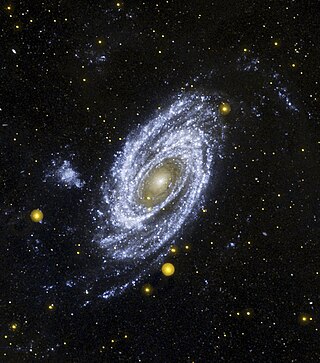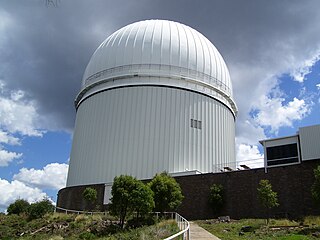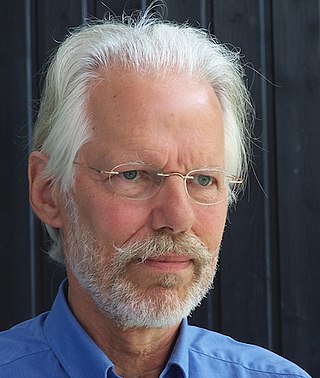Related Research Articles

Ultraviolet astronomy is the observation of electromagnetic radiation at ultraviolet wavelengths between approximately 10 and 320 nanometres; shorter wavelengths—higher energy photons—are studied by X-ray astronomy and gamma-ray astronomy. Ultraviolet light is not visible to the human eye. Most of the light at these wavelengths is absorbed by the Earth's atmosphere, so observations at these wavelengths must be performed from the upper atmosphere or from space.

Observational astronomy is a division of astronomy that is concerned with recording data about the observable universe, in contrast with theoretical astronomy, which is mainly concerned with calculating the measurable implications of physical models. It is the practice and study of observing celestial objects with the use of telescopes and other astronomical instruments.

The Australian Astronomical Observatory (AAO), formerly the Anglo-Australian Observatory, was an optical and near-infrared astronomy observatory with its headquarters in North Ryde in suburban Sydney, Australia. Originally funded jointly by the United Kingdom and Australian governments, it was managed wholly by Australia's Department of Industry, Innovation, Science, Research and Tertiary Education. The AAO operated the 3.9-metre Anglo-Australian Telescope (AAT) and 1.2-metre UK Schmidt Telescope (UKST) at Siding Spring Observatory, located near the town of Coonabarabran, Australia.
Observational cosmology is the study of the structure, the evolution and the origin of the universe through observation, using instruments such as telescopes and cosmic ray detectors.
The Sloan Digital Sky Survey or SDSS is a major multi-spectral imaging and spectroscopic redshift survey using a dedicated 2.5-m wide-angle optical telescope at Apache Point Observatory in New Mexico, United States. The project began in 2000 and was named after the Alfred P. Sloan Foundation, which contributed significant funding.

In astronomy, the 2dF Galaxy Redshift Survey, 2dF or 2dFGRS is a redshift survey conducted by the Australian Astronomical Observatory (AAO) with the 3.9m Anglo-Australian Telescope between 1997 and 11 April 2002. The data from this survey were made public on 30 June 2003. The survey determined the large-scale structure in two large slices of the Universe to a depth of around 2.5 billion light years. It was the world's largest redshift survey between 1998 and 2003. Matthew Colless, Richard Ellis, Steve Maddox and John Peacock were in charge of the project. Team members Shaun Cole and John Peacock were awarded a share of the 2014 Shaw Prize in astronomy for results from the 2dFGRS.

The Institute of Astronomy (IoA) is the largest of the three astronomy departments in the University of Cambridge, and one of the largest astronomy sites in the United Kingdom. Around 180 academics, postdocs, visitors and assistant staff work at the department.

The Low-Frequency Array, or LOFAR, is a large radio telescope, with an antenna network located mainly in the Netherlands, and spreading across 7 other European countries as of 2019. Originally designed and built by ASTRON, the Netherlands Institute for Radio Astronomy, it was first opened by Queen Beatrix of The Netherlands in 2010, and has since been operated on behalf of the International LOFAR Telescope (ILT) partnership by ASTRON.

Richard Salisbury Ellis is Professor of Astrophysics at the University College London. He previously served as the Steele Professor of Astronomy at the California Institute of Technology (Caltech). He was awarded the 2011 Gold Medal of the Royal Astronomical Society. and the 2022 Royal Medal of the Royal Society.
Amy J. Barger is an American astronomer and Henrietta Leavitt Professor of Astronomy at the University of Wisconsin–Madison. She is considered a pioneer in combining data from multiple telescopes to monitor multiple wavelengths and in discovering distant galaxies and supermassive black holes, which are outside of the visible spectrum. Barger is an active member of the International Astronomical Union.

Leibniz Institute for Astrophysics Potsdam (AIP) is a German research institute. It is the successor of the Berlin Observatory founded in 1700 and of the Astrophysical Observatory Potsdam (AOP) founded in 1874. The latter was the world's first observatory to emphasize explicitly the research area of astrophysics. The AIP was founded in 1992, in a re-structuring following the German reunification.
The Butcher–Oemler Effect is a scientific hypothesis suggesting the cores of galaxy clusters at intermediate redshift contain a larger fraction of blue galaxies than do the cores of low redshift clusters. The claim was first put forward by Harvey Butcher and Augustus Oemler in a 1978 Astrophysical Journal paper.

The Galaxy And Mass Assembly (GAMA) survey is a project to exploit the latest generation of ground-based wide-field survey facilities to study cosmology and galaxy formation and evolution. GAMA will bring together data from a number of world class instruments:
The Morphs collaboration was a coordinated study to determine the morphologies of galaxies in distant clusters and to investigate the evolution of galaxies as a function of environment and epoch. Eleven clusters were examined and a detailed ground-based and space-based study was carried out.
Gerald Kron was an American astronomer who was one of the pioneers of high-precision photometry with photoelectric instrumentation. He discovered the first starspot and made the first photometric observation of a stellar flare.

Warrick John Couch is an Australian professional astronomer. He is currently a professor at Swinburne University of Technology in Melbourne. He was previously the Director of Australia's largest optical observatory, the Australian Astronomical Observatory (AAO). He was also the president of the Australian Institute of Physics (2015–2017), and a non-executive director on the Board of the Giant Magellan Telescope Organization. He was a founding non-executive director of Astronomy Australia Limited.
George Kildare Miley is an Irish-Dutch astronomer. He holds a professorship at Leiden University, where he served as director of Leiden Observatory from 1996 to 2003.
MACS 1423-z7p64 is a galaxy listed in the MAssive Cluster Survey (MACS), and announced on 10 April 2017 in the journal Nature Astronomy, as being the most distant source of reionization known at this time, with a redshift z = 7.640 ± 0.001.

Klaas Sjoerds de Boer is a Dutch astronomer and astrophysicist as well as Professor at the University of Bonn. His research mainly consisted of using data obtained with satellites and from Earth bound telescopes.
References
- ↑ "ASTRON biographical summary". ASTRON. Archived from the original on 9 October 2006. Retrieved 23 November 2008.
- ↑ "Previous Bok Fellows". The University of Arizona. Archived from the original on 11 October 2008. Retrieved 23 November 2008.
- ↑ Harvey Butcher and Augustus Oemler, Jr. (1 January 1978). "The evolution of galaxies in clusters. I - ISIT photometry of C1 0024+1654 and 3C 295". Astrophysical Journal. 219: 18–30. Bibcode:1978ApJ...219...18B. doi:10.1086/155751.
- ↑ "The Morphs" Durham University, United Kingdom
- ↑ "RSAA News of the Month: September 2007". The Australian National University. Retrieved 23 November 2008.
- ↑ "Harvey Butcher". Royal Netherlands Academy of Arts and Sciences. Archived from the original on 7 February 2016. Retrieved 7 February 2016.
- "New head appointed to lead astronomy at ANU" ANU media release, 18 June 2007.
- "Early universe to be seen in southern hemisphere", ABC News, 8 October 2007